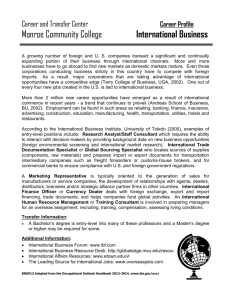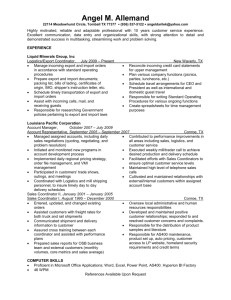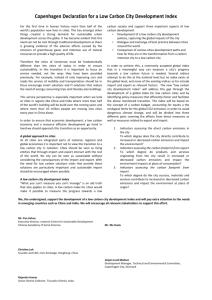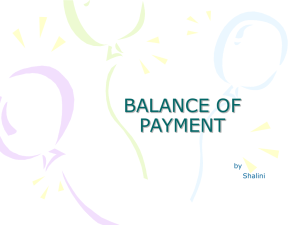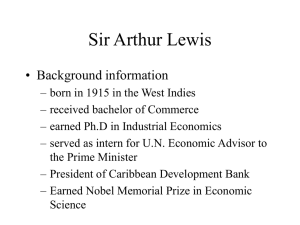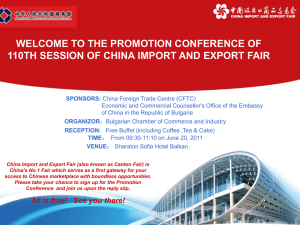Trade Facilitation - United Nations Economic Commission for Europe
advertisement
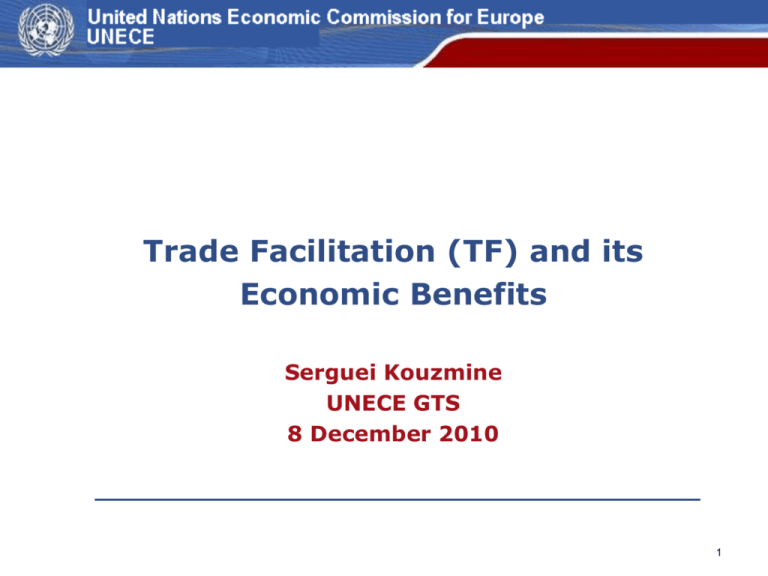
Trade Facilitation (TF) and its Economic Benefits Serguei Kouzmine UNECE GTS 8 December 2010 1 Recent trends in 2009 the global economic crisis sparked a 12.2% contraction in the volume of global trade. Ratio of world exports of goods and commercial services to GDP, 1981-2009 (Index 2000=100) The largest such decline since World War II. Source: IMF for world GDP, WTO Secretariat for world trade in goods and commercial services. Importance of trade facilitation « International Trade is one of the most important arenas in which we must combat the real effects of the crisis. Trade itself is a stimulus. » Source: Simon Crean, Australian Minister of Trade « Where the trade environment is more favorable, businesses are better positioned to take advantage of new opportunties, to grow and to great jobs when the global economy picks up again. » Source: WB, World Business Report, 2010 ….But in many economies cumbersome trade procedures, long delays and high trading costs continue to stifle trade potential. Where is trading easy—and where not? Easiest RANK Most difficult RANK Singapore 1 Niger 174 Hong Kong, China 2 Burkina Fasu 175 United Arab Emirates 3 Burundi 176 Estonia 4 Azerbaijan 177 Finland 5 Tajikistan . 178 Denmark 6 Iraq 179 Sweden 7 Congo Rep. 180 Korea, Rep. 8 Kazakhstan 181 Norway 9 Central African Rep. Afghanistan Israel Source: Doing Business database. 10 Doing Business Report 2011 Ranking indicators: • Documents to export & import 182 • Time to export & import 183 • Cost to export & import Data exchange in International Trade Purchase Exportation Importation • 20 actors • > 200 data elements; (60-70% re-keyed at least once, 15% retyped up to 30 times) • Manual procedures; • Multiple data systems; • > 30 documents or messages. Bill of lading, Documentation Vessel Booking Request Confirmed Line of Credit Importer’s Bank Vessel Booking Confirmation Exporter’s Bank Original B/L, Invoice, PO, Packing List Fund Transfer Line of Credit Proforma Invoice Rated Bill of Lading LC Confirmation Letter of Instruction Invoice, PO Shipping & funding detail Release/Hold Notice Inland Carrier Manifest Dock receipt Export Declaration AES Cargo Status Customs House Broker Pick-up & Delivery Order Shipping & Funding Detail Marine Insurance Company Demurrage guarantee & payment Dock receipt Freight Forwarder / NVOCC Import Terminal Operator Ocean Carrier Export Terminal Operator Exporter Proforma Invoice Arrival Notice Dock Receipt Purchase Order Importer Release/Approval Bill of Lading Import Docs Cargo Status Pick-up & Delivery Order Inland Carrier Customs ( Import ) Vessel Manifest Export Declaration Port Customs (Export) Importer Notice Converted Vessel Manifest Source: UNCTAD 2006 Too many documents… Enquiry Order Despatch advice Collection order Payment order Documentary credit Forwarding instructions Forwarder's invoice Goods receipt Air waybill Road consignment note Rail consignment note Bill of lading Freight invoice Cargo manifest Export licence Exchange control doc. Phytosanitary certificate Veterinary certificate Certificate of origin Consular invoice Dangerous goods declaration Import licence Customs delivery note TIR carnet Source: UNCTAD 2006 Number of documents to export and import Documents to Export (number) Region Documents to Import (number) DB 2011 DB 2007 DB 2011 DB 2007 OECD high income 4.4 4.5 4.9 5.2 East Asia & Pacific 6.4 6.8 6.9 7.5 Latin America & Caribbean 6.6 6.6 7.1 7.3 Middle East & North Africa 6.4 7.5 7.5 8.6 Eastern Europe & Central Asia 6.4 7.1 7.6 8.5 Sub-Saharian Africa 7.7 8.3 8.7 9.3 South Asia 8.4 8.5 9.0 9.4 Global Average 2010 6.5 7.3 Source: World Bank Doing Business 2011 Time to export and import Time to Export (days) Region Time to Import (days) DB 2011 DB 2007 DB 2011 DB 2007 OECD high income 11 11 11 12 East Asia & Pacific 23 24 24 26 Latin America & Caribbean 18 22 20 27 Middle East & North Africa 20 25 24 32 Eastern Europe & Central Asia 27 32 28 34 Sub-Saharian Africa 32 37 38 45 South Asia 32 35 33 38 Global Average 2010 23.1 25.8 Source: World Bank Doing Business 2011 What do traders want ? Simple and smooth processing of formalities Means to allow goods to proceed promptly to their final destination. No longer itineraries, no unpacking, no delays A single control point for all public services Standard forms, assembled into a ‘single bunch of documents’, compatible with trade documents and transport contracts Predictable and transparent rules and procedures Source: UNCTAD TRADE FACILITATION Simplification Process of eliminating all unnecessary elements and duplications in formalities, processes and procedures CSDAT Aug 2010 Source: UNECE, UNCTAD Harmonisation Alignment of national procedures, operations and documents with international conventions, standards and practices Standardisation Process of developing internationally agreed formats for practices and procedures, documents and information 10 The economic benefits of TF By reducing trade related transaction costs, delays at the borders, number of documents required,improving custom administration……., trade facilitation: Fosters businesses’ competitiveness Increases trade volumes and gains Raises countries’ GDP Boosts government tax revenues Some evidence…. Worldwide Trade related transaction costs are estimated to lie between 2 and 15% the value of imported goods (OECD 2001, 2003) Each 1% reduction of such costs is worth up an economic prize of USD 43 billion worldwide (OECD 2003) Some evidence (con’t d)… In APEC If APEC members, who perform below average, were able to improve their TF performance to half the APEC average, intraAPEC trade could increase by USD254billion and raise average APEC region GDP by 4,3 % (Wilson et al. 2004) If APEC members would reduce border delays by 1 day, they would increase exports by 1% (Martinez-Zarzosa et Marquez-Ramos 2008) Towards smart regulation Over the past 5 years, economies that rank high on the ease of trading across borders have: 1. Introduced or improved electronic data interchange systems 2. Introduced or improved risk-based inspections 3. Improved customs administration 4. Reduced number of trade documents 5. Improved procedures at ports 6. Introduced or improved single window 7. Implemented border cooperation agreements Source: WB, World Business Report, 2010 Opening a single window (SW) in Singapore & Korea ● In Singapore, the SW System (Trade Net) allows the business community to: submit 100 % of trade applications (9 mln per year) to all concerned government authorities with a processing time of 10 minutes ● In Korea, the SW System: Processes 80% of all import applications (3,000 per day) It is s used by 17 participating organizations and about 16,068 businesses from the trade community (as of December 2009). ● In both countries Firms’ savings in labor, printing, paper delivery, storage, inventory costs, etc. amount to approx US$ 1 billion per year . Source: UN/CEFACT Single Window Repository 2010 Россия в рейтинге «doing business» Беларусь Казахстан Россия Простота ведения бизнеса 58 63 120 Открытие бизнеса 7 82 106 Разрешение на строительство 44 143 182 Наём работников 32 38 109 Регистрация собственности 10 31 45 Получение кредита 113 43 87 Защита инвесторов 109 57 93 Уплата налогов 183 52 103 Трансграничная торговля 129 182 162 Исполнение договоров 12 34 19 Закрытие бизнеса 74 54 92 Как видят Россию? « Индекс развития ИКТ » - Россия - 48 место (Швеция-1; Германия-13; Франция-18: Беларусь-55; Казахстан-69; ..) « Индекс логистики » -Россия- 94 место (Германия-1; Швеция-3; Франция-17; Казахстан-62; Украина-102; ..) « Делать бизнес» - Россия - 120 место (Сингапур – 1; США – 4; Германия – 25; Франция – 31; Беларусь- 58; Казахстан –63,..) In summary Trade facilitation: Gives businesses a competitive edge Allows greater integration in the global economy Enhances government revenues Contacts: Sergei Kouzmine UNECE Global Trade Solution Section serguei.kouzmine@unece.org www.unece.org/trade
